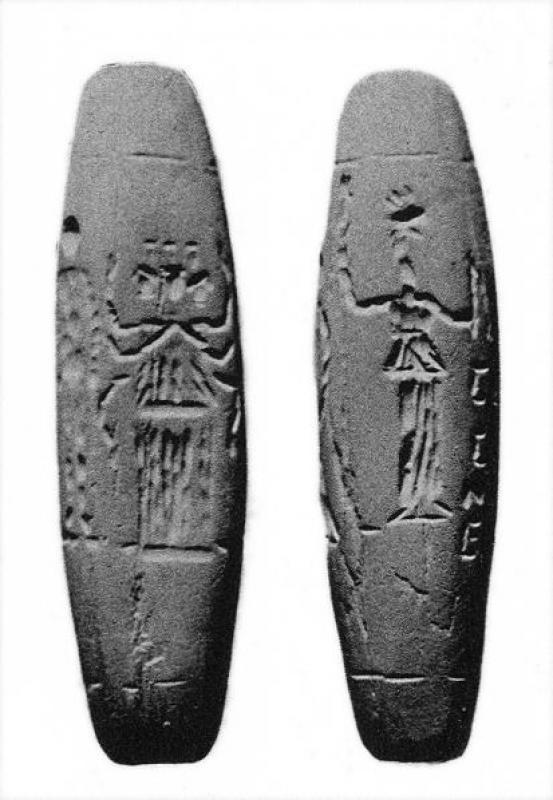Bonner, SMA, 242.
scribed at the beginning of this chapter. No matter how close the association between an inscription and a figure type may seem to be, there are usually exceptions, like this, that defeat any effort to find a positive meaning in the connection.
No. 26117 in the Michigan collection, known to have come from Syria, is slightly the largest of the group and rather crudely engraved (D. 367). On one of the flattened sides we find a triple Hecate. Next (turning the cylinder from right to left) in a narrow space, comes a woman with hand to lips. Then on the other broad side, a standing goddess; the place of her head is taken by a serpent which has three projections on the top of its head. The figure holds a tall staff in the right hand, a whip in the left; below the whip, σεσενγερ. Finally, in the narrow space to the left of Hecate there is an elongated, emaciated male form, probably meant for a shriveled corpse.
A specimen in the Walters Gallery differs from the others of the group in that its sides are almost straight; there is a barely perceptible tapering towards the rounded ends. It was pierced transversely, probably in modern times.41 Each of the two slightly flattened sides has two figures. First, Anubis above, in apron and boots, with caduceus in the right hand, a palm leaf on the left arm; below, Aphrodite drying her hair. It may be remarked in passing that the head of Anubis here, as on many other stones, could easily be mistaken for that of an ass rather than that of a dog or a jackal. On the opposite side, above, a woman with her right hand raised to her lips; below, the cock-headed anguipede. At the left of these figures, in a narrow space, a palm leaf, the letters ιαωιω, and three characters.
A stone of this class in the collection of Joseph Brummer (D. 369) shows a fairly well cut ibis-headed god standing on a pedestal. On the other side is the inscription νεθνομαω.
The most interesting stone of this group belonged to the Ayvaz collection and was published by Mouterde with a drawing.42 Here a familiar motif is introduced, the conventionalized vessel that is the representative of the uterus. In this instance, as occasionally elsewhere, it is shown with the mouth upwards. The object was recognized by Mouterde, but I venture to think that the figure over the vessel can be more accurately explained than he has done. The drawing shows a clumsy figure in a half-squatting position, the knees bent and turned outwards, the hands pressed against the abdomen. Mouterde suggests that it is Horus or Bes; but I have not seen Horus represented in this posture, and the head lacks the feathers that usually adorn the bandy-legged Bes. On the other hand, a uterine amulet in the Toronto Museum shows a female figure with swollen belly in exactly the same position as that on the Ayvaz bead.43 It is a woman straining in childbirth or else
41 D. 368.
42 R. Mouterde, Objets magiques, Recueil S. Ayvaz (Mélanges Univ. St.-Joseph, 25, 119, Νo. 40; Pl. 8). Not among the stones of this collection that were purchased by the University of Michigan.
43 D. 147.
Last modified: 2012-11-02 15:02:10
Link: cbd.mfab.hu/pandecta/1687
